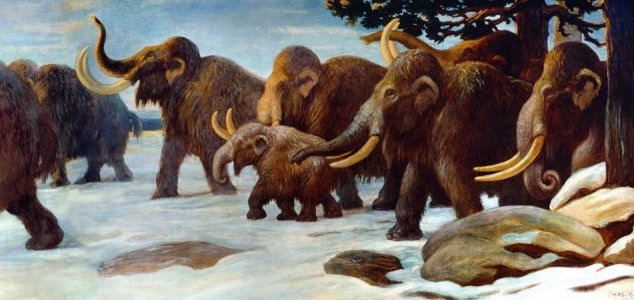Palaeontology
October 30, 2021 · 5 comments
5 comments

Humans and mammoths co-existed relatively recently. Image Credit: Charles R. Knight
Previous studies had indicated that while most mammoths likely died out around 10,000 years ago, a few had managed to survive in small populations on remote islands off the coast of Siberia.
There had even been suggestions that some of these isolated island populations had held on until around 4,000 years ago.
Now though, the results of a ten-year study involving the collection and analysis of 535 samples of sediment and permafrost from Siberia, Canada, Alaska and Scandinavia have yielded evidence to suggest that mammoths had still been roaming the wilds of mainland Siberia as recently as 3,900 years ago.
This means that these animals were still around after the construction of the Great Pyramid of Giza.
The researchers also determined that the woolly rhino had survived until around 9,600 years ago.
The findings involved analyzing traces of animal DNA found preserved in the sediment.
"An individual animal continuously spreads DNA throughout its lifetime in its dung, urine, epidermal cells, and hair, containing millions of DNA segments as it wandered across its full geographic range, but only left one skeleton upon its death, which is far less likely to have been preserved, recovered and dated," said study co-author Yucheng Wang from the University of Cambridge.
"By sequencing only a few of these DNA molecules preserved in the environment, we can identify its existence and range. It is therefore not surprising that sedimentary DNA could produce a later and more accurate extinction estimate."
Source: CNN | Comments (5)
Mammoths still roamed the Earth when Egypt's pyramids were being built
By T.K. RandallOctober 30, 2021 ·
 5 comments
5 comments
Humans and mammoths co-existed relatively recently. Image Credit: Charles R. Knight
A new study has shown that some Ice Age mammals survived much longer than previously thought.
While it is easy to imagine that giant Ice Age mammals such as the woolly mammoth and the woolly rhinoceros died out long before the advent of human civilization, research in recent years has shown that these animals survived much longer than anyone had realized.Previous studies had indicated that while most mammoths likely died out around 10,000 years ago, a few had managed to survive in small populations on remote islands off the coast of Siberia.
There had even been suggestions that some of these isolated island populations had held on until around 4,000 years ago.
Now though, the results of a ten-year study involving the collection and analysis of 535 samples of sediment and permafrost from Siberia, Canada, Alaska and Scandinavia have yielded evidence to suggest that mammoths had still been roaming the wilds of mainland Siberia as recently as 3,900 years ago.
The researchers also determined that the woolly rhino had survived until around 9,600 years ago.
The findings involved analyzing traces of animal DNA found preserved in the sediment.
"An individual animal continuously spreads DNA throughout its lifetime in its dung, urine, epidermal cells, and hair, containing millions of DNA segments as it wandered across its full geographic range, but only left one skeleton upon its death, which is far less likely to have been preserved, recovered and dated," said study co-author Yucheng Wang from the University of Cambridge.
"By sequencing only a few of these DNA molecules preserved in the environment, we can identify its existence and range. It is therefore not surprising that sedimentary DNA could produce a later and more accurate extinction estimate."
Source: CNN | Comments (5)

The Unexplained Mysteries
Book of Weird News
AVAILABLE NOW
Take a walk on the weird side with this compilation of some of the weirdest stories ever to grace the pages of a newspaper.
Click here to learn more

Support us on Patreon
BONUS CONTENTFor less than the cost of a cup of coffee, you can gain access to a wide range of exclusive perks including our popular 'Lost Ghost Stories' series.
Click here to learn more
Ancient Mysteries and Alternative History
United States and the Americas
Spirituality, Religion and Beliefs
Natural World
Total Posts: 7,767,644 Topics: 324,990 Members: 203,753
Not a member yet ? Click here to join - registration is free and only takes a moment!
Not a member yet ? Click here to join - registration is free and only takes a moment!



































Please Login or Register to post a comment.